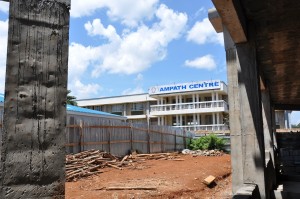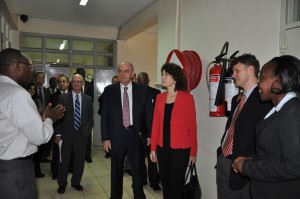‘We can do this — ourselves’
You read about it and hear about it, digest the facts and marvel at the statistics, but it’s an entirely different experience seeing and experiencing, first-hand, the AMPATH project here in Eldoret, Kenya. That might sound cliché, or maybe even trite. But there’s truly no other way to put it into words what it’s like touring this legendary program that has had such an astounding impact on millions of people in Kenya.
The history of the Academic Model Providing Access to Healthcare program is well documented but also well worth repeating. Conceived in the late 1980s by four IU physicians (Bob Einterz, Joe Mamlin, Charlie Kelley and Dave Van Reken), each of whom had experience in developing countries and a view that they could help better the lives of people around the world, the program took root as a full-fledged program in 1990, initially intended to link faculty and resources at the IU School of Medicine with the fledgling Moi University Faculty of Health Sciences — later to be renamed the Moi University School of Medicine. Just over a decade later, with 20 million Africans estimated to be infected with HIV, the virus that causes AIDS, the leaders of AMPATH would make a deliberate, one might say dramatic, decision to tackle the HIV pandemic in western Kenya.
Today, AMPATH, a partnership among IU, Moi University and the Moi Teaching and Referral Hospital, is one of the largest and most comprehensive academic centers for the treatment of AIDS in the world. Nominated multiple times for the Nobel Peace Prize, the program serves a population of 3.5 million people in over 500 urban and rural clinical sites throughout western Kenya and has enrolled more than 160,000 HIV-positive people.
AMPATH approaches the complex challenges of improving the health of Kenyans with a simply stated philosophy: Lead with care. This philosophy has demanded that the program’s leaders apply what they have learned in developing a successful system for treating HIV/AIDS into other areas critical to Kenyans’ survival, including food and income security and non-communicable chronic diseases in sub-Saharan Africa such as heart disease, hypertension, diabetes and cancer that are projected to far exceed that of HIV.
Throughout its development, AMPATH has also provided an opportunity for many of IU’s medical students, as well as students in the university’s School of Nursing and a number of other health science-related schools to gain vital real-life experience integral to their training. More than 1,000 American and Kenyan medical students and residents have participated in the program, which, in recent years, has received generous support from USAID, the United States Agency for International Development, as well as generous donors from Indiana.
Today was a historic day for AMPATH as IU President Michael A. McRobbie became the first IU president to visit the program since its inception, a monumental occasion not lost on one of its founders, Dr. Joe Mamlin (“call me ‘Joe'”), who possesses a bit of rock star status here in Eldoret, but with absolutely none of the pretensions. The evening before McRobbie and members of the IU delegation were scheduled to tour the AMPATH project, Dr. Mamlin (sorry; Joe) expressed how grateful he — “an old hillbilly from North Carolina” who has been at IU for more than five decades — was for the opportunity to host the president of a university that gave life to AMPATH and, in the course of doing so, hundreds and thousands of Kenyans.
That feeling of pride permeated an early-morning meeting at AMPATH, where program leaders, including program director Sylvester Kimaiyo, and his colleagues, Director of Moi Teaching and Referral Hospital John Kibosia and Fabian Esamai, principal of the Moi University College of Health Sciences, took turns expressing their gratitude to IU and their reflections on the program’s astounding success.
“I do not think I would’ve started an HIV program without the braveness and support of my colleagues at IU,” said Kimaiyo, who told a funny story about learning how to do email while studying in one of the infectious disease units at the IU School of Medicine. “It was thought that you couldn’t start an HIV hospital in Africa. Just impossible. But we did it. We started it. And now we are one of the biggest HIV programs in the world.”
From this initial meeting, Kimaiyo, Mamlin, Bob Einterz and IU executive field leader Adrian Gardner, who became involved with the program when he did his first rotation as a medical student in 2001, led McRobbie and members on the delegation an equal parts stunning and sobering tour of the impressive Moi Teaching and Referral Hospital and AMPATH Center — from the registration center where patients are first admitted to the pharmacy, labs, legal center, data center, medical and pediatric wards, and cardiac care unit, among several other areas, where medical staff from IU, Moi and other partnering institutions work together to treat suffering patients, many of whom would have no chance for survival if not for the AMPATH clinic.
The stories the IU delegation heard in each of these areas were often times staggering and accompanied by sights and sounds that enhanced their impact. Rachel Vreeman, a pediatrician in the Department of Pediatrics at the IU School of Medicine and one of the co-directors for the research field program for AMPATH, spends about half of the year in Kenya, seeing patients and conducting research that she hopes will children’s health care in western Kenya. She explained to McRobbie that the pediatric clinic at the AMPATH Center will average 100 children a day who have been exposed to HIV/AIDS. Roughly half of those children will contract the virus. In contrast, the entire state of Indiana will see 50 HIV/AIDS-infected children in an entire year, she said. (Vreeman’s blog chronicles her time at AMPATH.)
Just getting children to an AMPATH clinic is a huge achievement, Vreeman and others added, as the costs and stigma associated with having a child with HIV causes many families not to seek treatment. Likewise, in the neo-natal clinic and pharmacy, where bottles of medication were stacked up in a massive pile, stories were told about patients who no longer take their prescriptions because, in some cases, a dosage might cost more than their monthly salary.
And yet there were also stories of incredible progress and potential. As they walked through several treatment wards, members of the IU delegation learned that more and more Kenyans were getting early treatment due to early detection efforts, increased disclosure so that children are told of their HIV status (research indicates that only 11 percent of Kenyan children know whether they are carrying the virus), supportive counseling activities to help erase the stigma of HIV and retention efforts. AMPATH leaders believe that one of its main program pillars, called Find, Link, Treat and Retain, or FLTR, can ultimately create a new, HIV-free generation in Kenya.
In the data center, delegation members learned about transitioning from ragged scraps of paper records to new, high-tech records systems, advanced by researchers at IU and the Regenstrief Institute at IUPUI, with close to 700,000 individuals in them and more than 4.5 million visits.
In the Sally Test Center, a child-life center located within the hospital wards that caters to sick and abandoned children, the young patients and their caregivers happily sang a hello song to their visitors, including to IUPUI Executive Vice Chancellor Nasser Paydar, who is accompanying the delegation on the Kenya portion of its Africa tour.
Toward the end of the tour, delegation members donned hard hats to view what will soon become a new, four-floor, high-efficiency Chronic Disease Building, fueled in part by solar power and scheduled to open in 2015. The building will contain outpatient clinics, research space, classrooms and seminar rooms, and it represents a critical component of AMPATH’s strategy to control and prevent a wide range of chronic, non-communicable conditions and diseases.
And then there was Njoki. In 2002, Njoki was pregnant when a pre-natal exam revealed she was HIV-positive. Left by her husband and alone on the streets of Eldoret with the stigma of HIV, she found her way to AMPATH, where she eventually learned to string beads into ribbons and necklaces that she was encouraged to sell. Today she is production manager of the Imani Workshops, established in 2005 to provide job training and income-generation activities for those affected by HIV and others in need. The group now employs more than 100 members and sells jewelry, bowls, stationary, bags and other items, with 100 percent of the income earned through the sales revenue reinvested in the workshops.
At the end of telling her inspirational story, Njoki spoke proudly of coming to IU and to the Herron School of Art and Design at IUPUI, where she received several months of training. “So now,” she laughed, “ I, too, can say that I am a member of IU.”
Indeed, she would have been right at home when, during a lunchtime gathering held in between activities at AMPATH, President McRobbie formally recognized the Kenya chapter of the IU Alumni Association as the university’s newest official alumni community.
In remarks to about 100 IU Kenyan alumni, McRobbie talked about AMPATH and the transformative power of education and research in action. The wide-ranging collaboration, he added, proves the truth of an African proverb, “Partnership must be more than a word. It must be a behavior.”
Joe Mamlin has a similar saying, referring to the heroic work being done here in Eldoret, which several AMPATH staff repeated today: “We can do this — ourselves.”
After today, it was easy to see the truth in those words, too, and feel pride in IU’s role in launching the miraculous AMPATH program.
“I’m absolutely proud I’m from Indiana University,” Mamlin said last night. “This is a program that’s different from any collaborative program anywhere in Africa. The struggle here is to be a part of doing something that’s meaningfully different for entire populations instead of just having a fun clinic to teach or do a research project.
“And, you know what, it’s all because of Indiana University. I can’t think of any school I’d rather be identified with.”
Tags: Adrian Gardner, Africa, Aids, AMPATH, Bob Einterz, Eldoret, Fabian Esamai, Herron School of Art and Design, HIV, Imani Workshops, Indiana University, IU, IU School of Medicine, Joe Mamlin, John Kibosia, Kenya, Michael McRobbie, Moi University, Nasser Paydar, Rachel Vreeman, Sylvester Kimaiyo





